Casado Costa Rica – Replicate It At Home!
This post may contain affiliate links.
The Costa Rican casado is the main meal of the day- it’s the perfect Costa Rican lunch! Here are multiple casado recipes for your enjoyment!
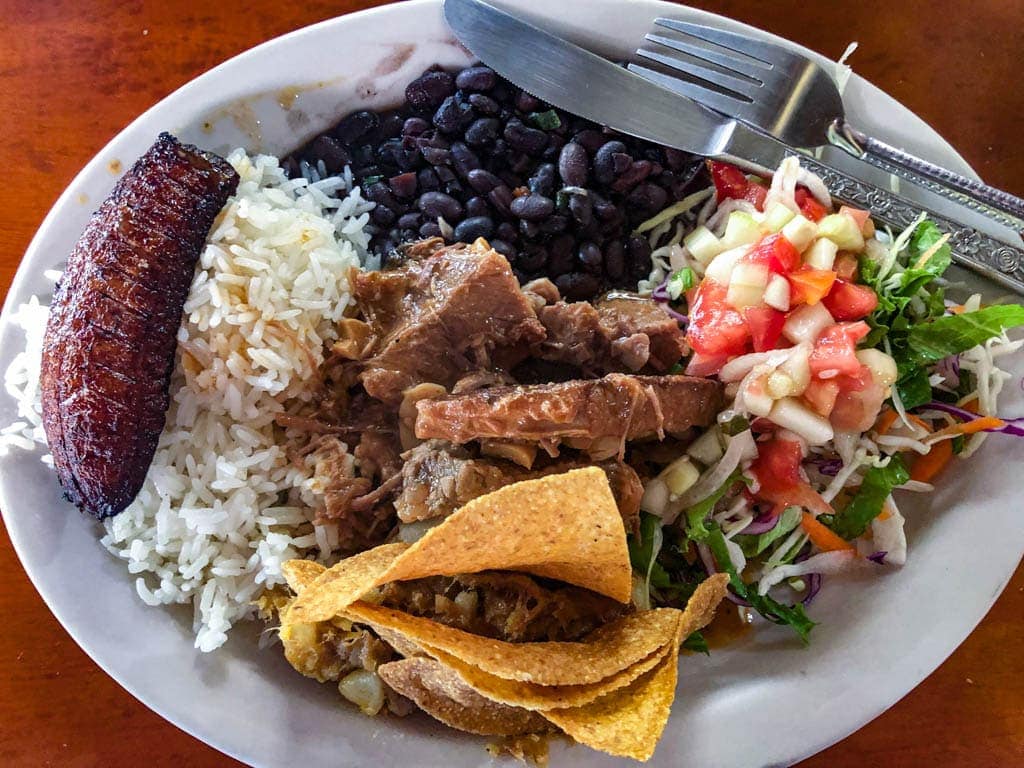
About The Costa Rican Casado
Hearty, flavorful, and full of different variations, the casado is one of Costa Rica’s most beloved signature dishes.
Casados are a lunchtime fixture and are a fantastic way to prepare a nutritious meal with seasonal ingredients. Casados originally began appearing on the Costa Rican culinary scene when laborers took banana leaf wraps of vegetables and meat to work with them. Those protein packets were prepared by their wives and eventually evolved into the casado platters of today.
RELATED POST: 30+ Foods To Try In Costa Rica
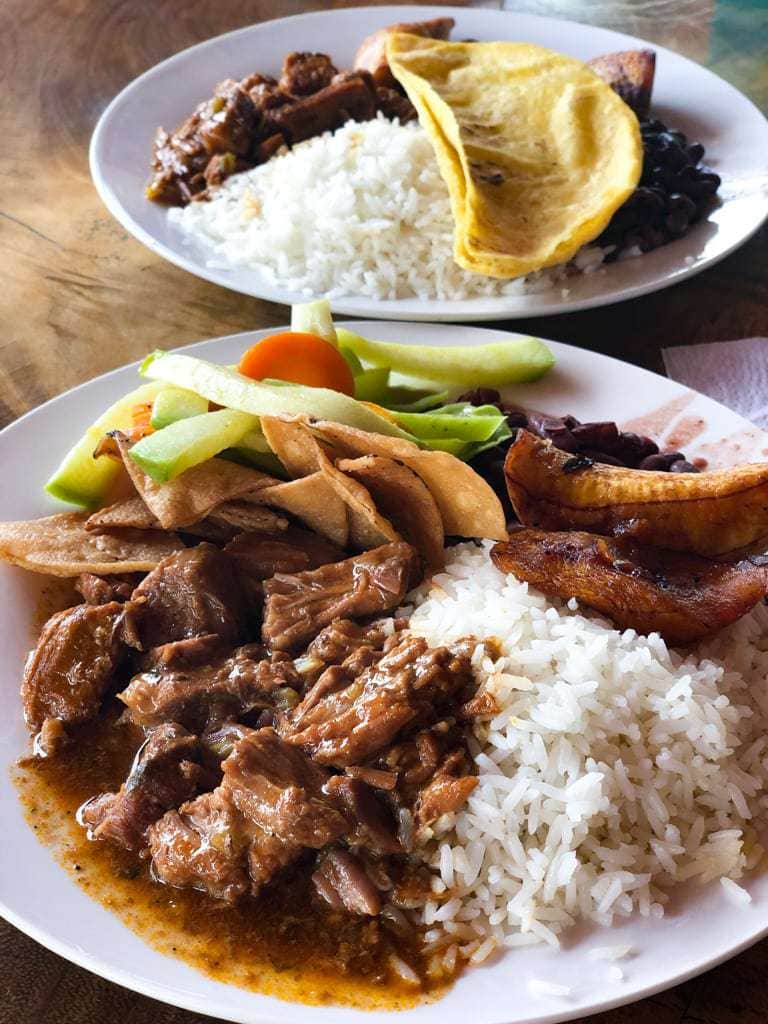
Casado Meaning
Casado in Spanish literally means “married” or “married man,” giving the dish an affectionate nod to the wives that would put together meals for their working husbands. Another way school of thought on the casado’s name is that it “marries” together a variety of dissimilar, yet delicious foods.
The casado is the most traditional Costa Rican lunch- made up of Costa Rican white rice, red or black beans, protein, fried plantains, and usually a homemade picadillo or sauteed vegetables- all on one plate.
Since lunch is the main meal of the day in Costa Rica, the casado is the highlight of Costa Rican cuisine. Costa Ricans generally eat a very light dinner (if they eat dinner at all), this meal gets you through to the next coffee time (4-6 pm) and then off to bed.
History of the Casado in Costa Rica
There are a few theories about the origin of the casado in Costa Rica. From what I have been able to tell, in the 1960s there was a surge in the number of people (mostly men) in Costa Rica working in the capital city of San Jose.
They would need to eat lunch away from their homes and would eat in small sodas where one woman would cook for many people. Ticos are known for their big lunch appetites so they would ask for more food than they were served.
This led to the cocineras (cooks) joking that it was like being at home- their casado (husband) would always ask for more. Thus the casado Costa Rica was born.
Related post: What Is Salsa Lizano From Costa Rica
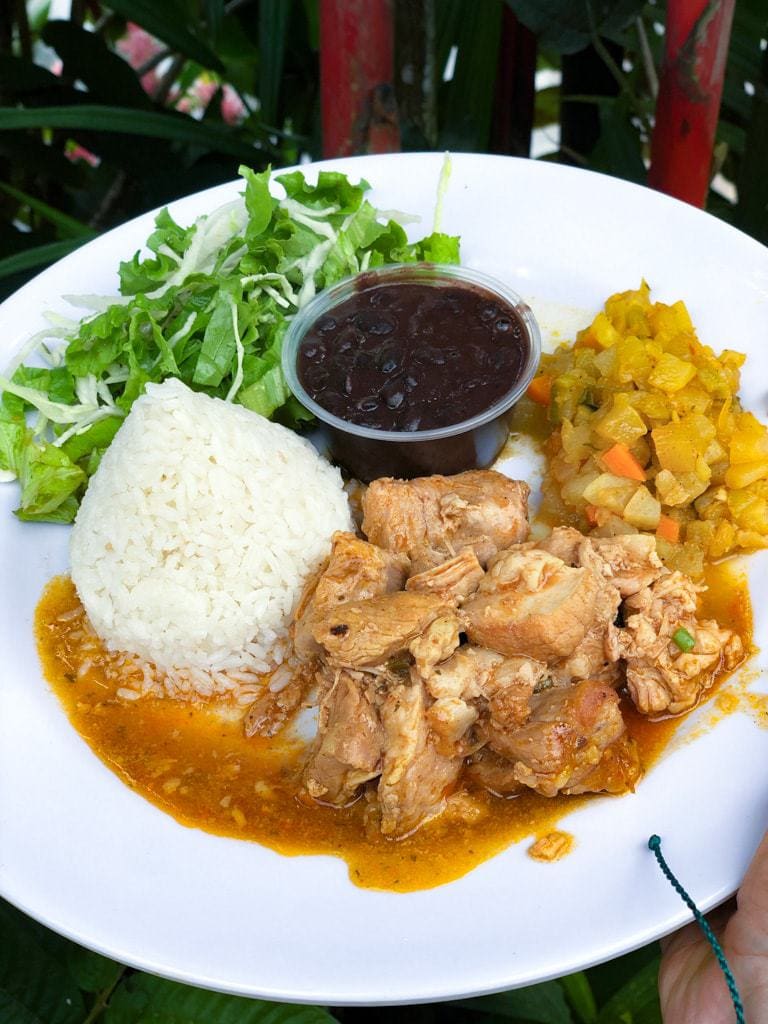
Where To Get a Casado in Costa Rica
The casado is literally on every menu. But- choosing the place where you will eat your casado is a different story. You can find sodas, restaurtantes, and buffets for your casado. Here’s how you choose:
Soda
Sodas are often tiny little local restaurant spots that offer a plato ejecutivo which is basically the casado of the day and a homemade Costa Rican juice for a set price. This price is almost always under $4- it’s aimed at working people who can’t go home for lunch.
A soda will almost always offer a variety of other casado options as well- they just might cost more. (Like $5-$6 instead of $4). You will pay 13% tax and 10% service here. This is a great option for a fast, sit-down meal.
Related post: Saving Money In Costa Rican Restaurants
Buffet
Buffets are often on main highways where truckers and roaming workers stop. They are not traditional American buffets, they are buffets in the sense that you can see the food and tell the worker what you want. They have a plate and serve you what you ask for, and then charge accordingly.
I have never figured out the system for price at these places, but it’s always cheap so I don’t really worry about ordering whatever I want. You will pay 13% tax here but not the 10% service fee. These places are sort of get in, eat, and leave.
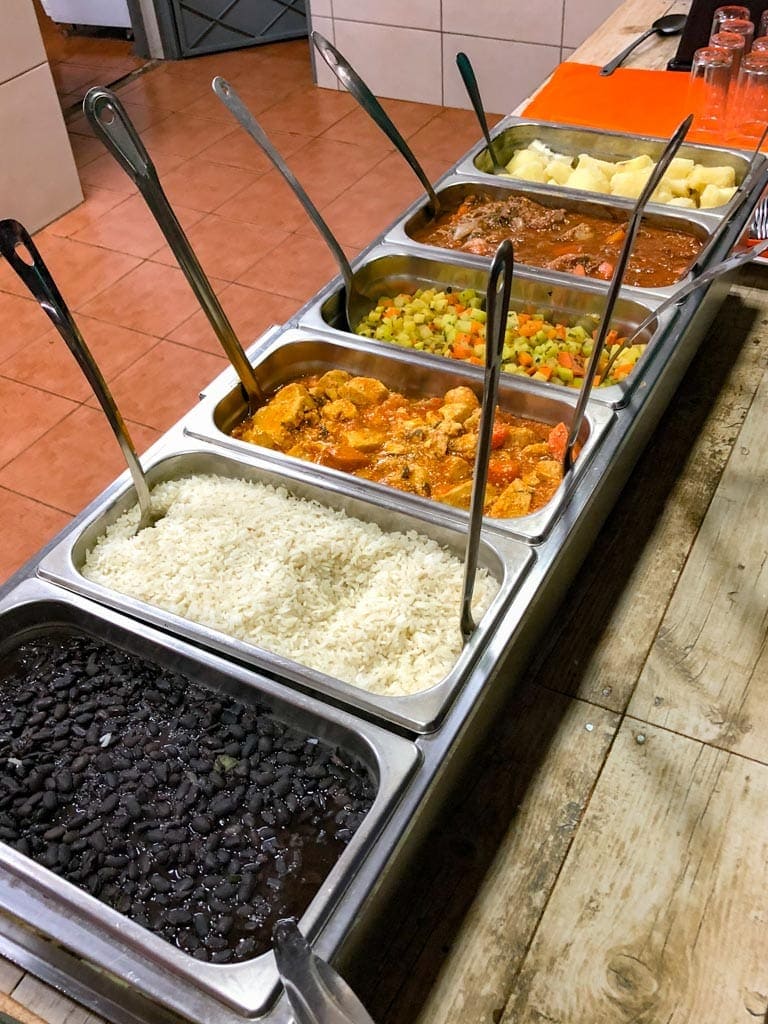
Restaurant
Restaurants are traditional sit-down places with tablecloths and a waiter. You’ll have a printed menu, and a variety of drink options, and the pace here is much slower. Prices are a bit higher- you can expect to pay about $10 for a casado, plus the 13% tax and 10% service fee. You can also have a leisurely lunch, order a beer, and just enjoy your afternoon.
How To Order A Costa Rican Casado
You’ll generally find the casado on pretty much any menu. You’ll see it listed as casado de… and then the protein.
I feel like the menu description only gives you part of the story though. You don’t know what extras you will have or what picadillo is featured.
Because of that, I ask a lot of questions and I ask to have my casado personalized according to my preferences (ie- I always ask for a side of French Fries). Costa Ricans like to help people, and they are picky eaters, so it is very common for a person to order a casado de carne (meat casado) and customize basically everything except the carne.
Some questions to ask:
- ¿Cuál es el picadillo de hoy? – What’s today’s picadillo?
- ¿Me lo puede traer con huevo frito? – Would you bring it with a fried egg?
- ¿Me lo hacen con pinto en vez de arroz blanco? – Will you make with gallo pinto instead of white rice?
- ¿Cuáles son la guarniciones que trae? – What are the sides that it comes with?
Once you have ordered your casado exactly how you want it, you just wait for the deliciousness to appear!
Related post: Basic Spanish Phrases For Travel
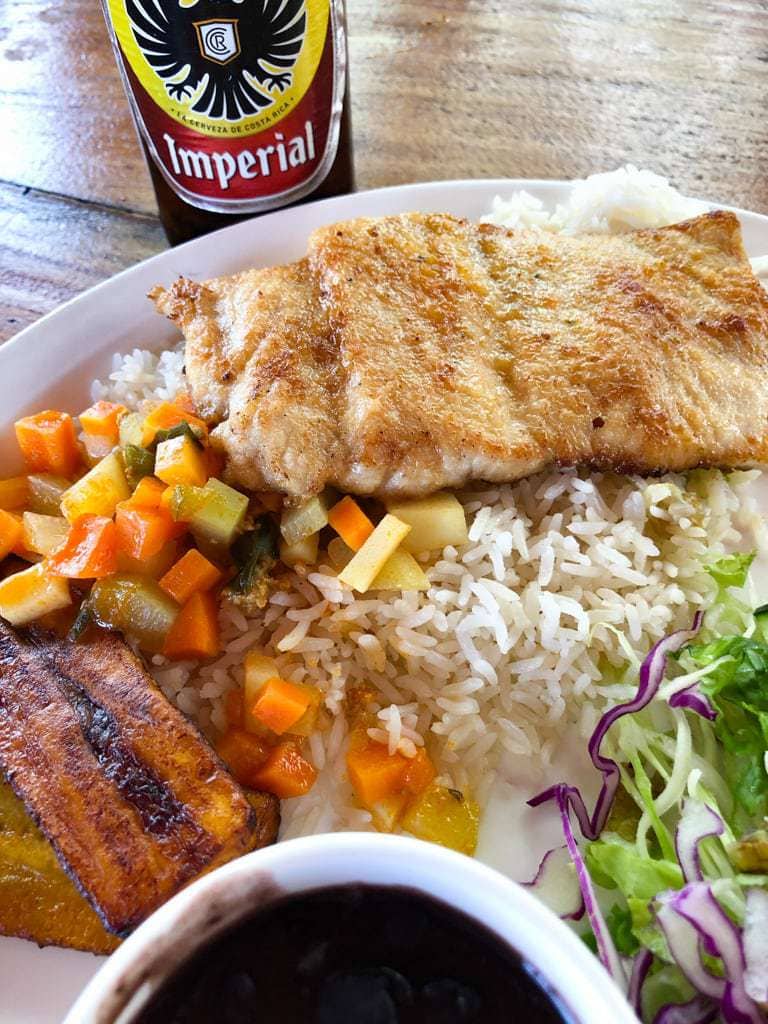
How To Make A Costa Rican Casado
A Costa Rican casado has a bunch of different traditional foods all on the same plate- and it’s a HUGE portion! Since the casado was originally meant to get hard laborers (coffee pickers, farmers, etc) through the afternoon, it’s a very hearty meal.
The casado is also a way to cut way down on food waste. You make fresh beans and rice in the morning for gallo pinto, then serve them separately for lunch in the casado. Then you just make whatever dishes you have on hand and serve them on the same plate.
Casados are labor-intensive for the cook- which is why the name refers to a married man. Traditionally in Costa Rica, women spent the day in the kitchen preparing fresh meals for the family.
Leftovers were often frowned upon (and still are in many homes), so women got creative with the casado.
Maybe you had leftover tuna salad from dinner that you didn’t want to throw away? It becomes a pasta salad with tuna and fresh veggies.
Leftover beans? Make them into black bean dip and serve them on the casado with fresh corn tortillas. You get the idea.
RELATED POST: Olla de carne- Costa Rica’s National Dish
Essential Casado Ingredients
A Costa Rican traditional casado typically consists of protein, fiber, starch, salad, and tortillas. It’s sort of like the original superfood bowl, except on a plate.
To really drill down to more specifics, the casado will always have fresh beans (red beans or black beans depending on the region of the country), white rice, picadillo, and green salad. The protein will generally be fish, chicken, pork or red meat- but the variations on those can be endless. If you need a vegetarian or vegan option, you can just omit the protein.
Additional Casado Ingredients
In addition to the staple ingredients mentioned above, Costa Rican casados can be adorned with the following extra ingredients:
- fried eggs
- fresh cheese
- fried plantains
- refried beans
- fresh avocado
- hard-boiled eggs
- tortilla chips
- plantain chips
- sour cream
- pasta salad
- chimichurri
- corn tortillas
Examples of Costa Rican Casados
Here are some photos of traditional Costa Rican casados I have eaten recently, with a quick description of the ingredients in each one.

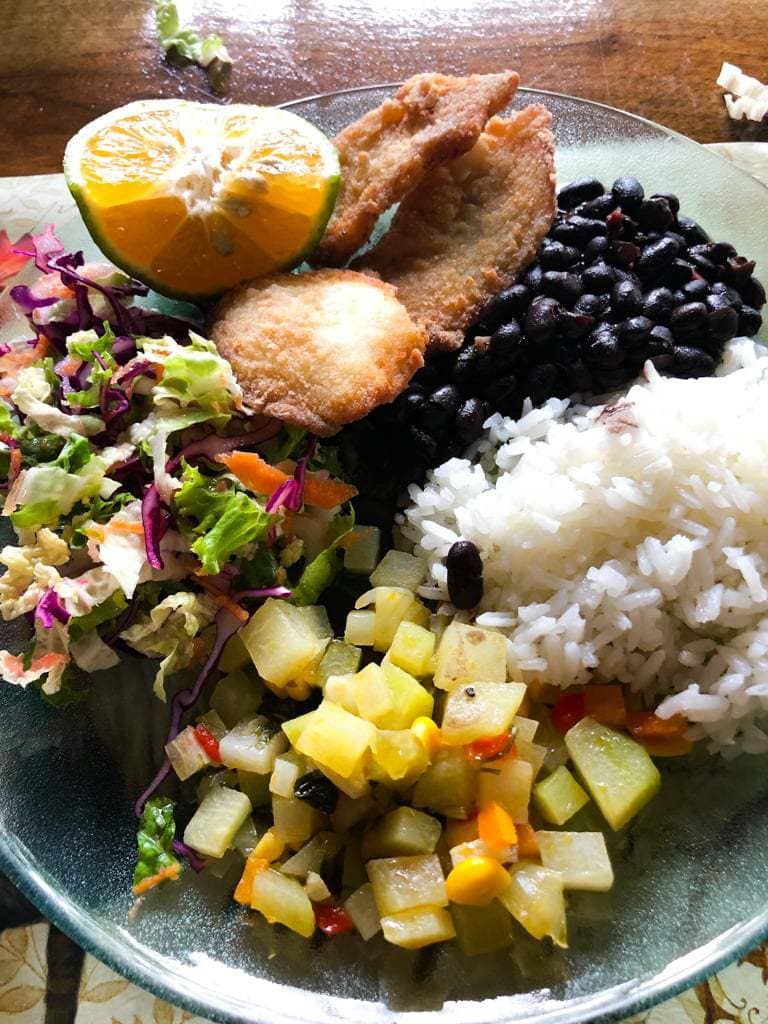
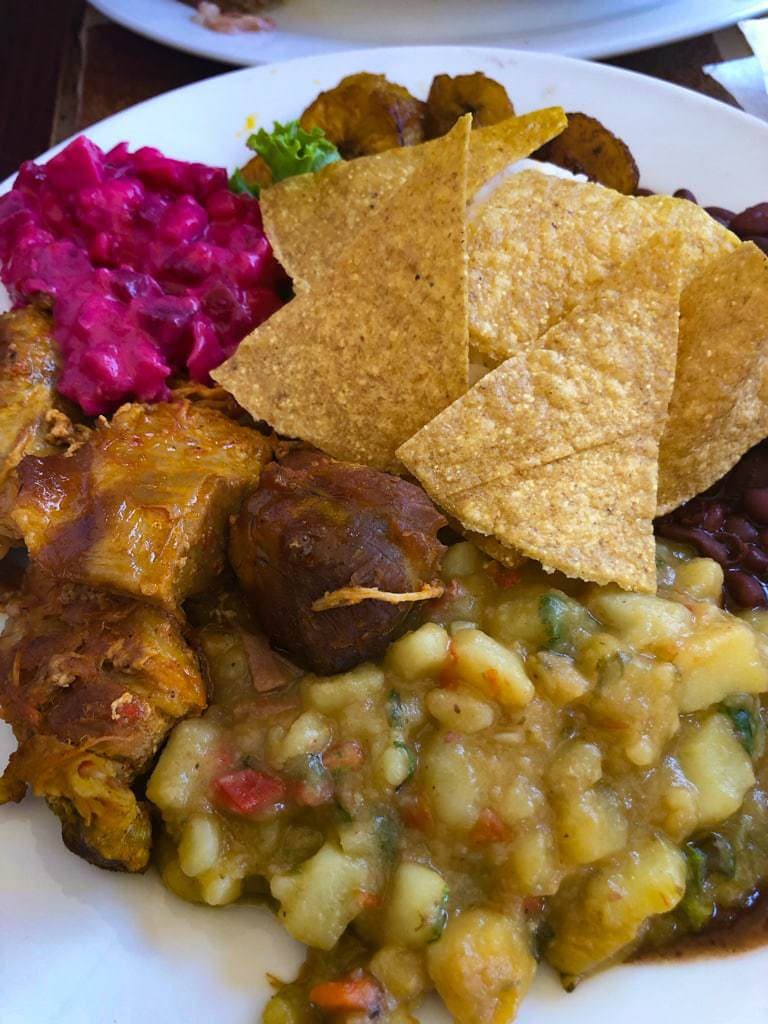

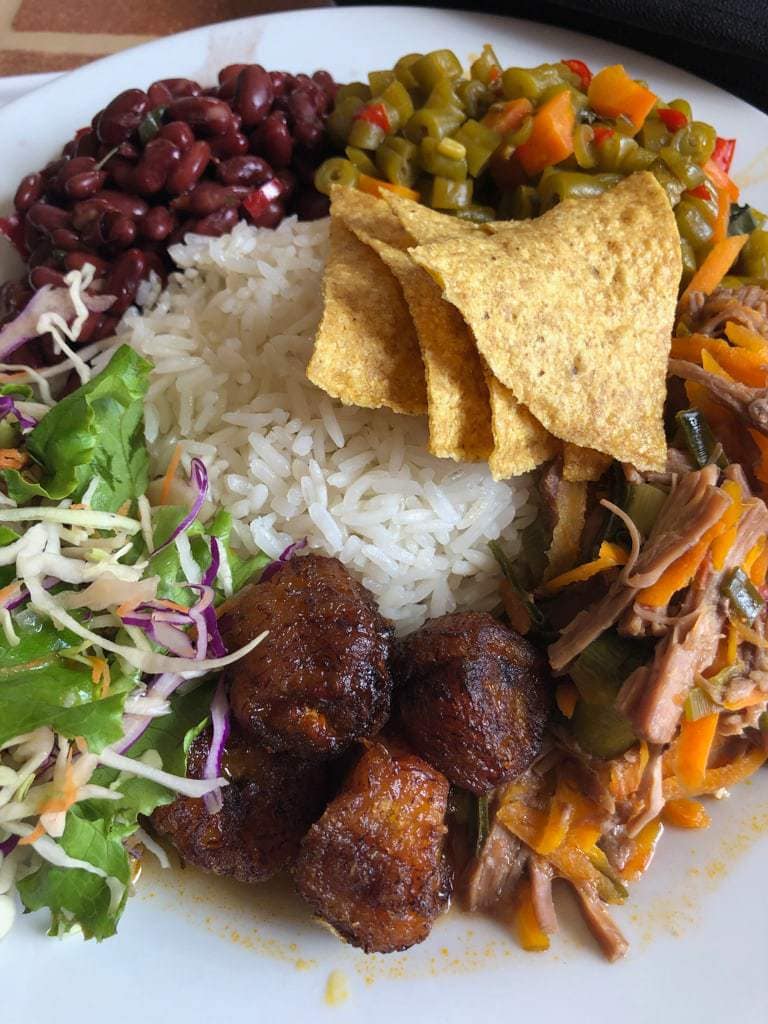
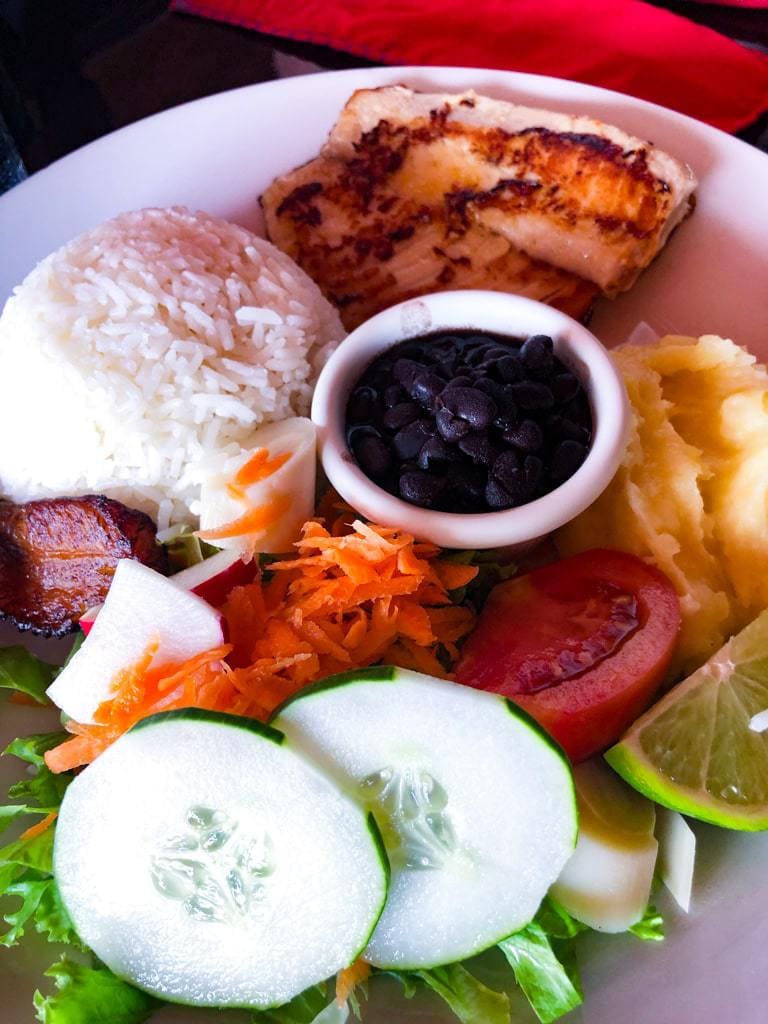

Costa Rican Casado Recipe
As we discussed before, there are a million casado variations. For this one, I am going to publish my very favorite casado- what I would order in my favorite soda if they had absolutely everything I wanted.
Since heading all the way down to a Costa Rican soda might be a bit of a stretch, here’s how to bring the casado to your home!
For variations then, you can look at the photos above and make up your own favorite combination.
Ingredients:
- 1 cup Costa Rican white rice
- 1 cup Costa Rican black beans
- 1 cup Costa Rican beef in red sauce
- 1 /2 cup Picadillo de chayote
- 2-3 Fried plantains
- 1 fried egg
- 1 slice of fresh cheese (queso fresco or other)
- 1/2 cup Shredded lettuce, and carrot with a side of lime
- 1/4 cup Chimichurri sauce
- Salsa Lizano
Instructions:
Place all ingredients on a huge plate and serve warm with a smile and Salsa Lizano. A traditional casado is also generally served with a curtido which is a fermented Costa Rican hot sauce for drizzling over your plate.
Note- these instructions are a tad bit vague. That’s because making a Costa Rican casado can take most of the morning. Generally, you will rise early and make the rice and beans. While they are cooking you shower and dress.
Make gallo pinto for a traditional Costa Rican breakfast with some of the rice and beans, and leave the rest for lunch.
As the morning progresses you might make your picadillo and meat and leave them warm on the stove.
Right before lunch you’ll chop up your lettuce, make your chimichurri, and fry up some plantains.
Once your people come home for lunch, you serve a bit of this and a bit of that until the plates are full!

Substitutions
The possibilities are endless- see photos above. Here is a list of substitutions and their Spanish translation by type:
Protein substitutions
- Grilled chicken breast – pollo a la plancha
- Breaded chicken breast – pollo empanizado
- Chicken in sauce (usually red) – pollo en salsa roja
- Breaded fish fillet (always ask what type of fish it is and when it was caught) –pescado empanizado
- Chicken fajita – fajitas de pollo
- Grilled fish fillet – pescado a la plancha
- Flank steak with onions – bistec emcebollado
- Pork cracklings – chicharrón
- Steak fajitas – fajitas de res
- Porkchop – chuleta de cerdo
- Fried egg – huevo frito
- Hard-boiled egg – huevo duro
Picadillo substitutions
- Green bean picadillo – picadillo de vainica
- Potato picadillo – picadillo de papa
- Mixed picadillo – picadillo mixto
- Arracache picadillo – picadillo de arrachache
- Chayote picadillo – picadillo de chayote
Starch substitutions
- Gallo Pinto – gallo pinto
- Rice and Beans (Caribbean) – “riceanbeans”
- Fried rice (not very common) – arroz frito or arroz a la jardinera
- Red beans – frijoles rojos
- Refried beans – frijol molido
- Yucca – yuca frita
Plantain substitutions
- Fried plantain – plátano frito
- Boiled plantain – plátano hervido
- Patacones – patacón
- Mashed potatoes -pureé de papa
- Tortilla chips – tortilla fritas
Salad Substiutions
- Pasta salad – ensalada de caracolitos
- Heart of Palm salad – ensalada de palmito
- Russian Salad – ensalada rusa
Note: Not everywhere has all of these options, and not everywhere has the same options each day. Just ask.
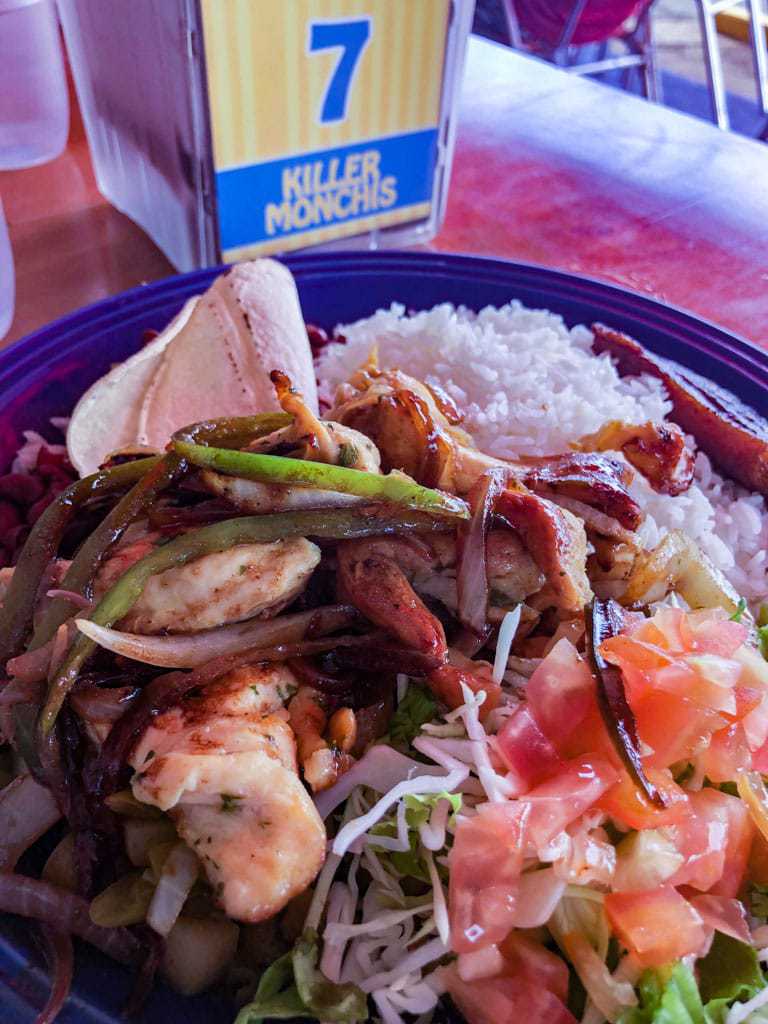
Variations
It is becoming increasingly popular to have a vegan or vegetarian casado- and people are understanding in restaurants if you have these dietary restrictions. Since the casado has so many vegetables to begin with, it is easy to customize according to your dietary needs.
Though the baseline casado usually includes beans, rice, salad, plantains, and protein, there are all sorts of delicious side dishes that can be added in! Casados can be served with fried plantain chips, picadillo hash, pico de gallo, and even fried eggs.
The picadillo is especially versatile since it consists of diced and sauteed seasonal vegetables. Picadillo de papa (potato picadillo) and picadillo de chayote (chayote squash picadillo) are especially popular, but just about any vegetable hash will go well with a casado!
A casado can be made both vegetarian and vegan by omitting the shredded chicken and increasing the amount of gallo pinto. Vegan picadillo de vainica can be added in to make the meal more substantial.
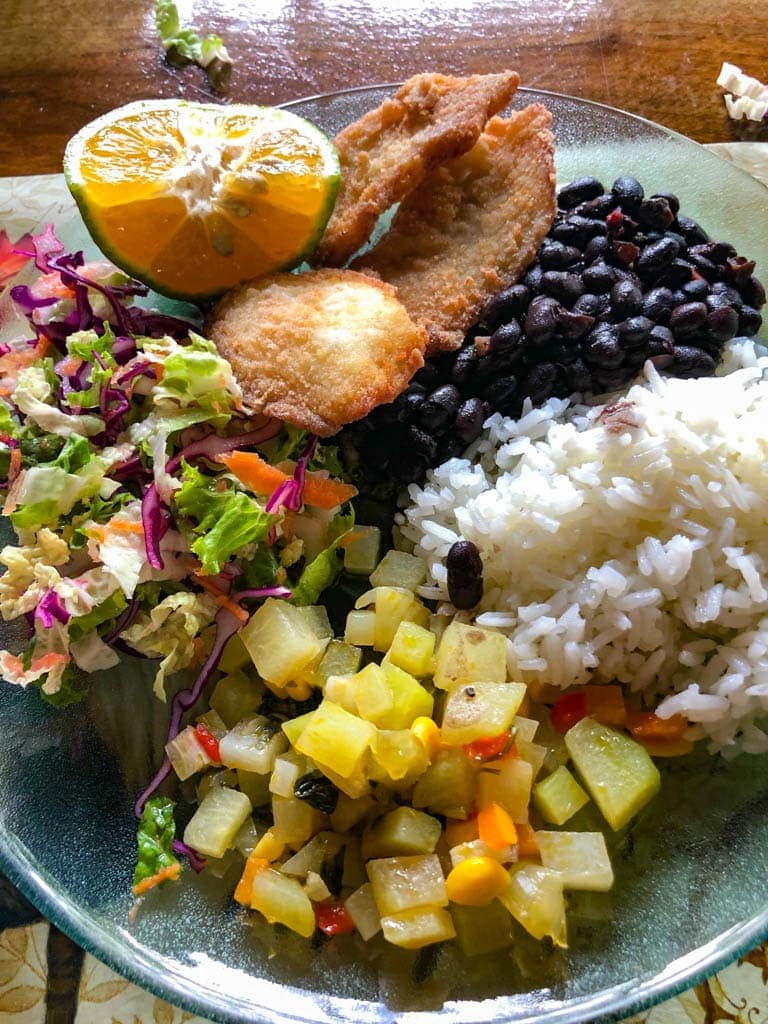
Serving Suggestions
The casado is often served with a freshly made juice beverage and a side of Costa Rican tortillas. Popular juices include tamarindo, guayabana, blackberry (mora- my absolute favorite), chan, mango, orange, pineapple, passion fruit, star fruit, guava, and lemonade- among many others.
FAQ
What is Costa Rica’s national dish?
Gallo pinto, a traditional bell pepper, rice, and bean medley, is recognized as Costa Rica’s national dish. Though not the official national dish, casado is also considered a staple of Costa Rican culinary culture, as is the vegetable beef soup- olla carne.
How much does a casado cost?
Casado typically costs about $7 USD, but can run up to around $11 USD in tourist locations.
Is salad safe to eat in Costa Rica?
Generally, yes! Costa Rican produce is usually very fresh and well-prepared. Since the entire country has potable drinking water in all homes and restaurants, consuming fresh produce in Costa Rica is generally not a concern.
Printable Recipe
Costa Rican Casado Recipe
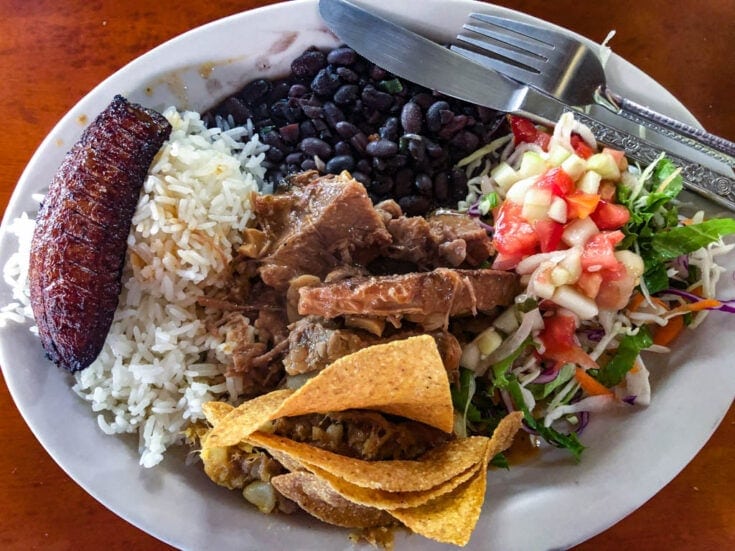
The Costa Rican casado is the main meal of the day- it's the perfect lunch! Here are multiple casado recipes for your enjoyment!
Ingredients
- 1 cup Costa Rican white rice
- 1 cup Costa Rican black beans
- 1 cup Costa Rican beef in red sauce
- 1 /2 cup Picadillo de chayote
- 2-3 Fried plantains
- 1 fried egg
- 1 slice of fresh cheese (queso fresco or other)
- 1/2 cup Shredded lettuce, and carrot with a side of lime
- 1/4 cup Chimichurri sauce
- Salsa Lizano
Instructions
Place all ingredients on a huge plate and serve warm with a smile and a bottle of Salsa Lizano.
Notes
Note- these instructions are a tad bit vague. That's because making a Costa Rican casado can take most of the morning. Generally, you will rise early and make rice and beans. While they are cooking you shower and dress.
Make pinto for breakfast with some of the rice and beans, leave the rest for lunch.
As the morning progresses you might make your picadillo and meat and leave them warm on the stove.
Right before lunch you'll chop up your lettuce, make your chimichurri, and fry up some plantains.
Once your people come home for lunch, you serve a bit of this and a bit of that until the plates are full!
Recommended Products
As an Amazon Associate and member of other affiliate programs, I earn from qualifying purchases.
Nutrition Information:
Yield:
1Serving Size:
1Amount Per Serving: Calories: 3044Total Fat: 172gSaturated Fat: 53gTrans Fat: 3gUnsaturated Fat: 96gCholesterol: 681mgSodium: 2833mgCarbohydrates: 190gFiber: 34gSugar: 57gProtein: 184g
Please double-check this information with your favorite nutrition calculator.
Don’t forget to pin it!
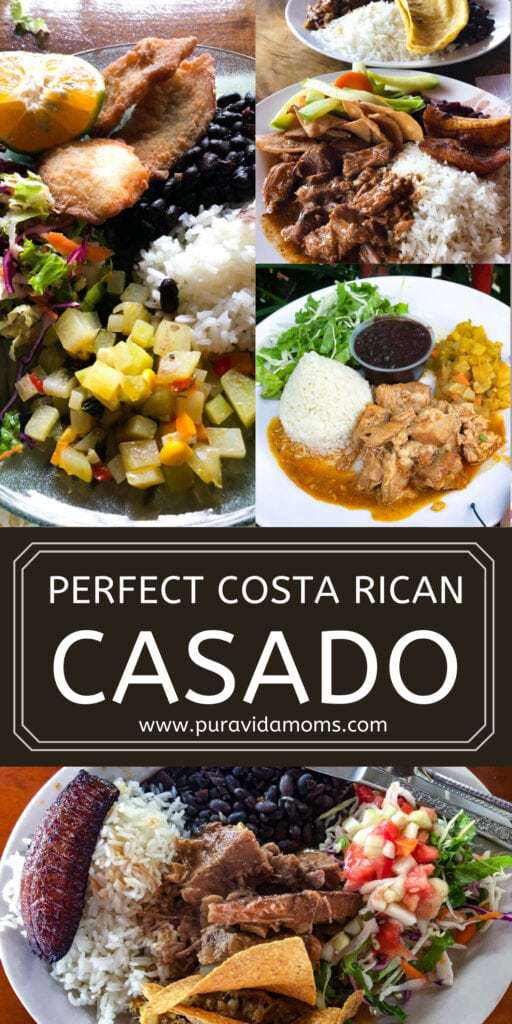

Christa Jimenez
Welcome! I’m Christa, a Spanish teacher married to a handsome Costa Rican and mother of two bilingual daughters. We’ve spent over 25 years living in and traveling to Costa Rica with our daughters, and this website is my love letter to all things Costa Rica- and to bilingual parenting too. You can read my full story here. Thanks for stopping by!

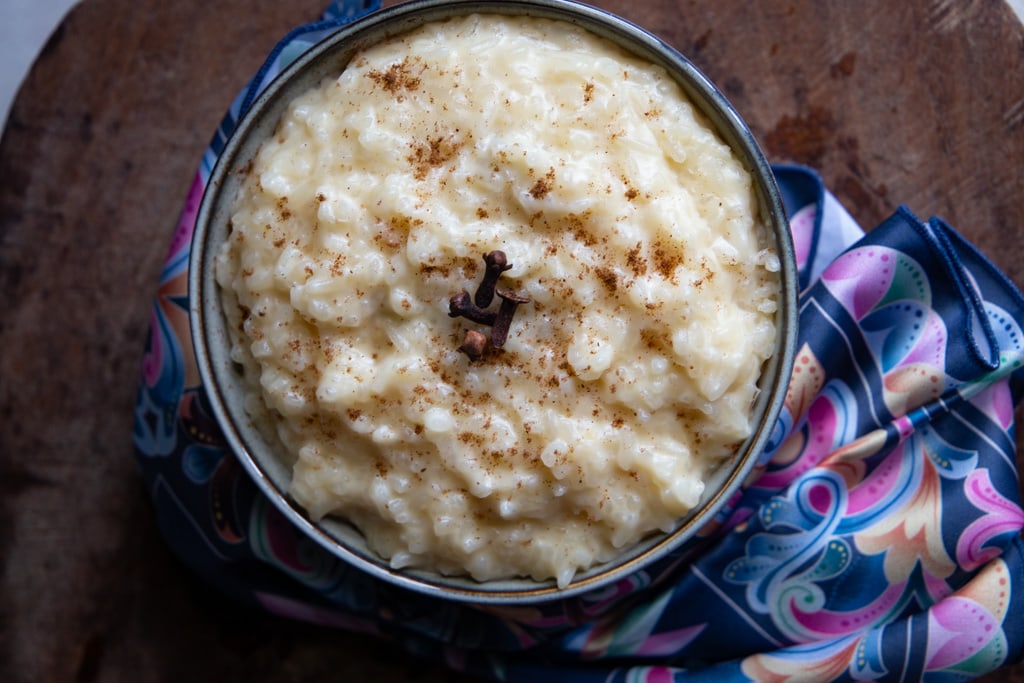
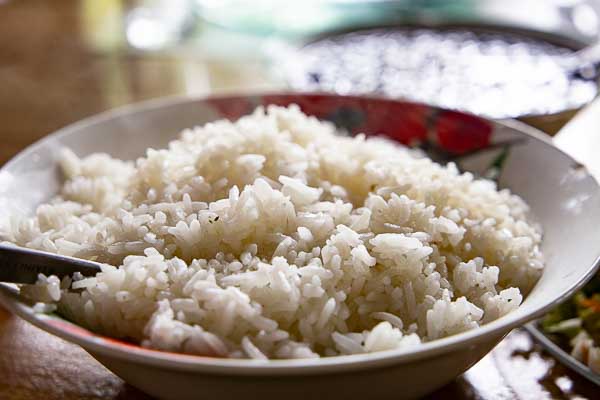
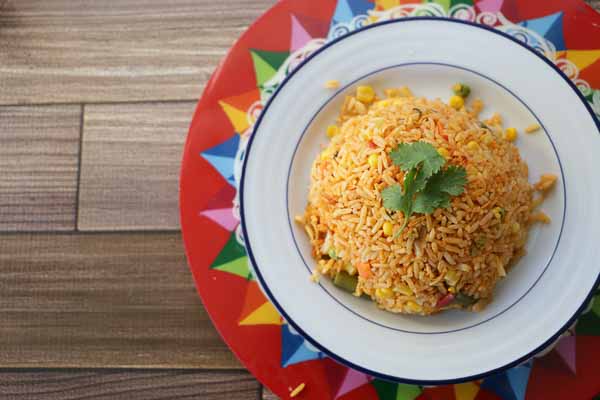
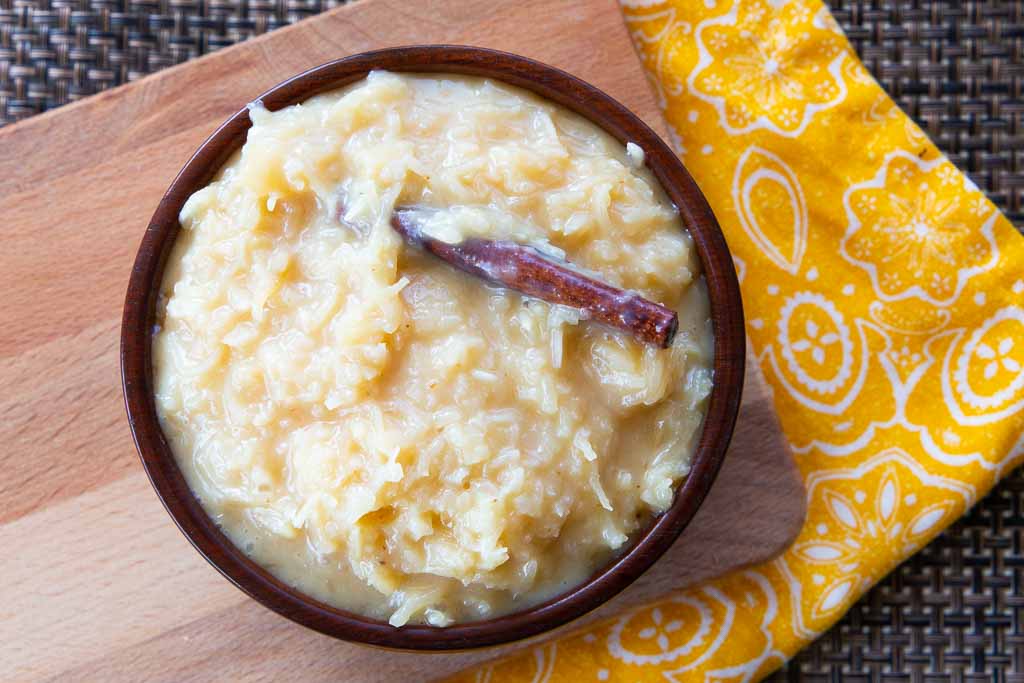
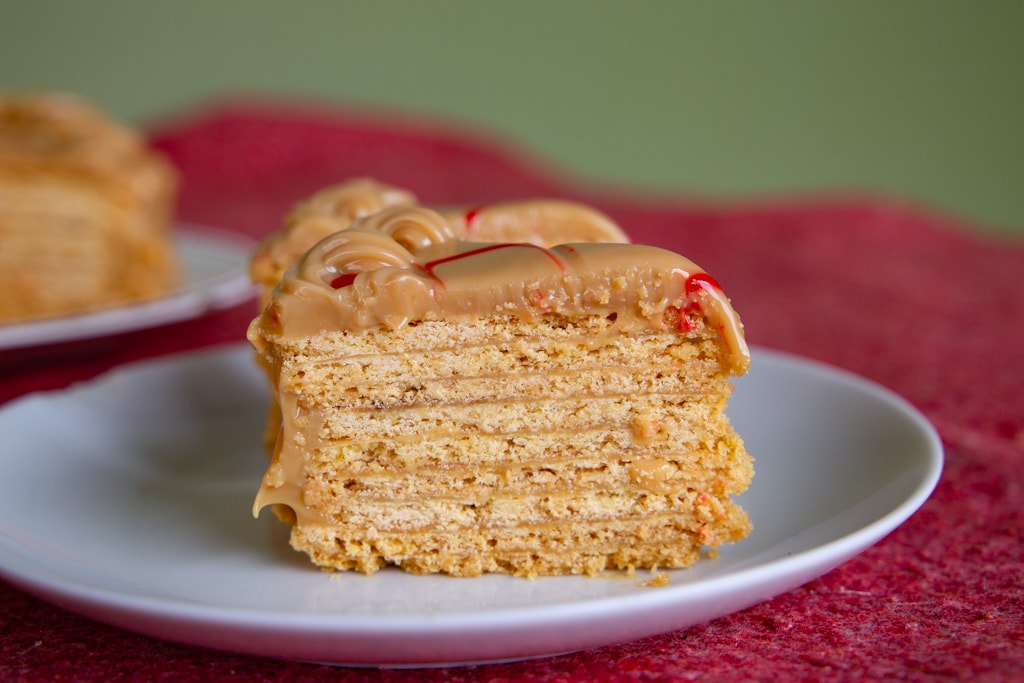
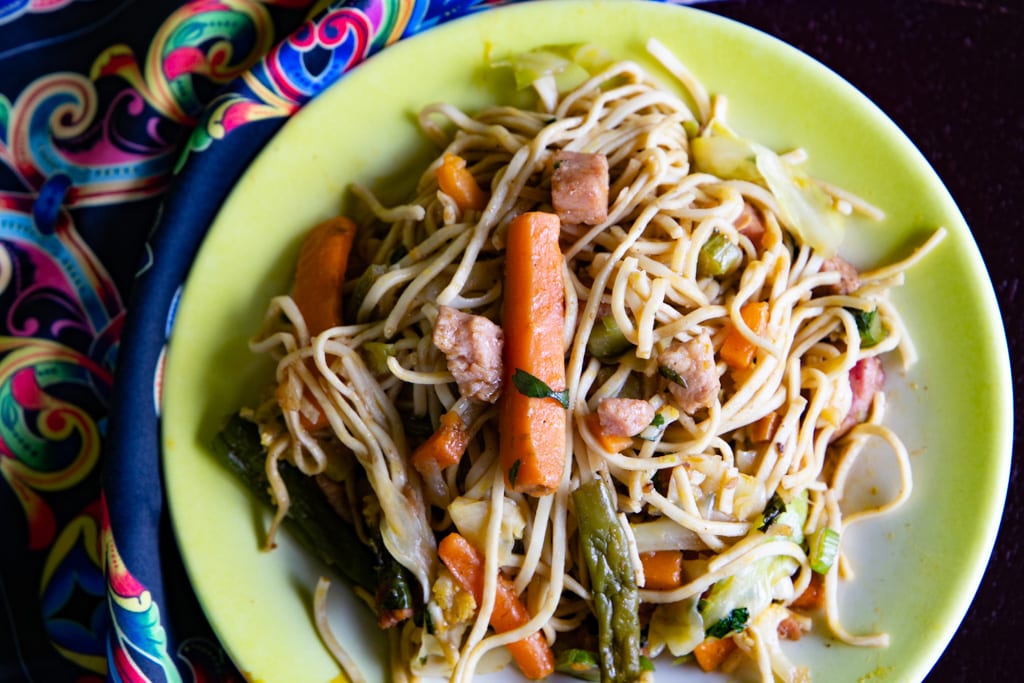

I cannot wait to try these recipes!
Thank you for such an amazing and informative post! So much information there, and I learned a lot!
I’m sooo glad it was helpful. Pura vida! ~Christa